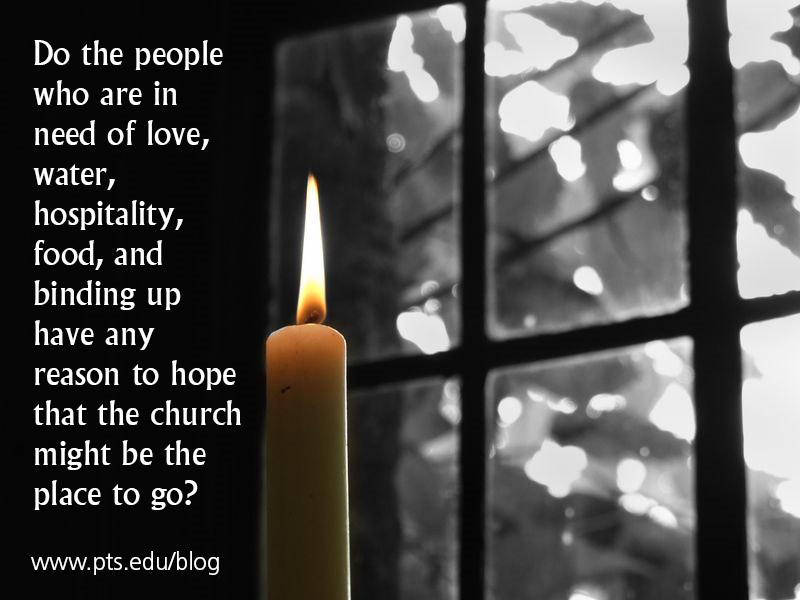When I was a kid, probably seven or eight, somewhere around Christmas time my family volunteered with a program that offered winter housing in our church for people experiencing homelessness. I remember helping to pour the cereal for breakfast, chatting with some of the people, and experiencing a somewhat confusing set of instructions about both politeness to our guests and safety from them. Whatever some of their struggles may have been, as a child, after spending a bit of time with the guests, I had no sense of their being different from me in any fundamental way. I walked away grateful for the experience, but somewhat unsettled about the way we as a church related to our guests. I couldn’t quite put it into words, but it didn’t totally make sense.
Not long after, my father, a Presbyterian elder and a deep believer in Christmas decorations, was explaining the different Christmas decorations we put up and their origins, no doubt in response to a question from me regarding why we couldn’t have a tree up all year. He was, as dads often do, answering the question with an extended monologue about Christmas decorations generally and particularly, their internal logic, diverse origins, and varied manifestations. I was tuning out—until he arrived at the lights in the windows.
“The candles in the windows are a symbol of welcome. In the cold of winter, they show that our house offers welcome to those in need and welcome to Jesus coming into the world.”
I latched on immediately. This was the disconnection I had felt at our church program. “Daddy, that is great! But . . . do the people in need know that that is what the lights mean? Because I know they are probably cold. So, if they see the lights, are they just supposed to knock? Is this what everyone means by the candles in the windows? I’ve never known anyone who actually had someone come and stay with them because of the candles. If they aren’t working, perhaps a sign makes more sense . . . ”
To this day, I don’t know whether my Dad was consciously teaching me a lesson about double speak, the world and the church, or simply back-peddling from a moment of regretted honesty with his kid. Generally regretted honesty wasn’t his style. “No,” he said, “that isn’t really how it works. We can’t really invite just anyone into our house. The window candles are a symbol. They remind us to welcome Jesus and each other, particularly around Christmas.”
Then, as now, I have real questions about symbols that symbolize something we don’t mean. If symbols are as fluid as I think they are, it seems like it won’t take long for our symbols to mean something different to those who see them than what we keep saying that they mean. Do the candles mean welcome? If we are forced to be honest, we have to say, no—not in any concrete sense. Is there such a thing as a theoretical welcome?
The same is true for all the church symbolizes—the Kingdom of God, loving ones neighbor (regardless of faith affiliation—see Luke 10:30-37), offering a cup of cold water to the thirsty, visiting people in prison, feeding the hungry, binding up the broken hearted. If all of that is theoretical, I have real questions about whether it exists at all. Do the people who are in need of love, water, hospitality, food, and binding up have any reason to hope that the church might be the place to go?
Indeed the reasons these symbols have held such power is that the story they tell—one of life out of death, one of repairing the breach and restoring streets to live in—that story is powerful and moving and even revolutionary. But does the capital “C” Church still practice those acts often enough to symbolize those things to a watching world?
Perhaps it does to some—but what about the others? What about those who experience church as intimidating, isolating, or baffling? For those who see church as for some other sort of person than they are? Those who don’t know that in this church we don’t wear hats in worship and that sweat pants wouldn’t be accepted as appropriate worship wear? Those who can’t read music or those who don’t know you never sit in the fourth row because that is Bessie’s seat and has been since 1973? What about those who can’t read?
Could starting new churches be a way to recommit to being a part of the Gospel, the Good News that is, as the angel tells us, for all the people? Could it be a way to broaden the bridge that the body of Christ has already built to bring us insiders the good news?
If the church is ever to be a symbol of the Kingdom of God on earth—if we are ever to signify the body of Christ at work on earth—then for our sake, I pray so.
This is the first blog post of the Rev. Karen Rohrer, the new director of the Church Planting Initiative at Pittsburgh Theological Seminary. Before joining the CPI team, Karen was co-pastor and co-founder of Beacon, a Presbyterian Church in the Kensington section of Philadelphia. The saints of Beacon taught her contextual ministry, the joy of being church, and the unique grace of being a lady pastor and boss in a neighborhood of matriarchs. The building of Beacon taught her amateur handy-woman and moisture remediation skills, and that a particular space really can be a reminder that you are loved. As director of the Church Planting Initiative, she is excited to vision new ways the church can bear good news to the world, and to support and resource the leaders God is calling forth to make it so.


There’s noticeably a bundle to learn about this. I assume you made sure nice points in features also.